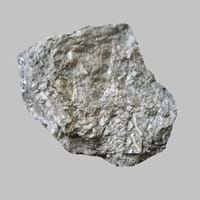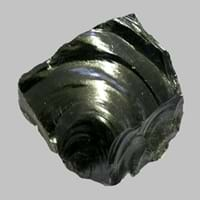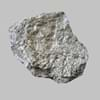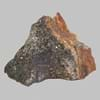Definition
Whiteschist is an uncommon rock type belonging to a class of metamorphic rock, this is formed at high-ultra-high pressures
Obsidian is a naturally occurring volcanic glass formed as an extrusive igneous rock. It is produced when felsic lava extruded from a volcano cools rapidly with minimum crystal growth
Discoverer
Unknown
Obsius
Etymology
From French schiste, Greek skhistos i.e. split
From Latin obsidianus, misprint of Obsianus (lapis) (stone) of Obsius
Class
Metamorphic Rocks
Igneous Rocks
Sub-Class
Durable Rock, Soft Rock
Durable Rock, Medium Hardness Rock
Group
Not Applicable
Volcanic
Other Categories
Fine Grained Rock, Medium Grained Rock, Opaque Rock
Opaque Rock
Color
Colourless, Green, Grey, White
Black, Blue, Brown, Green, Orange, Red, Tan, Yellow
Durability
Durable
Durable
Scratch Resistant
Yes
Yes
Appearance
Banded and Foilated
Shiny
Interior Uses
Decorative Aggregates, Interior Decoration
Decorative Aggregates, Interior Decoration
Exterior Uses
Garden Decoration, Paving Stone
Garden Decoration
Other Architectural Uses
Curbing
Not Yet Used
Construction Industry
for Road Aggregate
Arrowheads, Cutting Tool, Knives, Scrapers, Spear Points
Medical Industry
Not Yet Used
Surgery
Antiquity Uses
Artifacts, Monuments, Sculpture, Small Figurines
Artifacts, Jewellery
Commercial Uses
Creating Artwork, Gemstone, Jewelry, Production of Lime
Creating Artwork, Mirror, Used in aquariums
Types
Not Available
Fireworks Obsidian, Mahogany, Sheen Obsidian, Snowflake obsidian and Velvet Peacock Obsidian
Features
High percentage of mica, Host Rock for Lead
Blocks negativity, Helps to protect against depression
Archaeological Significance
Monuments
Used
Not Yet Used
Famous Monuments
Data Not Available
Not Applicable
Sculpture
Used
Not Yet Used
Famous Sculptures
Data Not Available
Not Applicable
Figurines
Used
Not Yet Used
Formation
Whiteschist is formed by dynamic metamorphism at high temperatures and pressures that aligns the grains of mica, hornblende and other elongated minerals into thin layers.
When the lava is released from volcano, it undergoes a very rapid cooling which freezes the mechanisms of crystallization. The result is a volcanic glass with a uniform smooth texture.
Mineral Content
Carbonate, Coesite, Quartz, Silica
Not Available
Compound Content
CaO, Mg, MgO, Silicon Dioxide
Aluminium Oxide, CaO, Iron(III) Oxide, FeO, Potassium Oxide, MgO, MnO, Sodium Oxide, Phosphorus Pentoxide, Silicon Dioxide, Titanium Dioxide
Types of Metamorphism
Not Applicable
Burial Metamorphism, Cataclastic Metamorphism, Contact Metamorphism
Types of Weathering
Biological Weathering, Chemical Weathering, Mechanical Weathering
Biological Weathering, Chemical Weathering, Mechanical Weathering
Types of Erosion
Chemical Erosion, Coastal Erosion, Glacier Erosion
Chemical Erosion, Coastal Erosion, Glacier Erosion
Grain Size
Fine to Medium Grained
Not Applicable
Fracture
Conchoidal
Conchoidal
Porosity
Less Porous
Very Less Porous
Luster
Subvitreous to Dull
Vitreous
Cleavage
Perfect
Non-Existent
Toughness
1
Not Available
Specific Gravity
2.86
2.6-2.7
Transparency
Opaque
Translucent
Density
2.8-2.9 g/cm3
2.6 g/cm3
Resistance
Heat Resistant
Heat Resistant, Impact Resistant
Deposits in Eastern Continents
Asia
Afghanistan, Bangladesh, Bhutan, China, India, Japan, Kazakhstan, Malaysia, Pakistan, Russia, Thailand, Turkey, Vietnam
Afghanistan, Indonesia, Japan, Russia
Africa
Egypt, Ethiopia, Morocco, Nigeria, South Africa
Kenya
Europe
Austria, England, France, Georgia, Germany, Italy, Liechtenstein, Monaco, Norway, Slovenia, Spain, Sweden, Switzerland
Greece, Hungary, Iceland, Italy, Turkey
Others
Not Yet Found
Not Yet Found
Deposits in Western Continents
North America
Canada, Costa Rica, Cuba, Mexico, Panama, USA
Canada, Mexico, USA
South America
Brazil, Colombia, Guyana
Argentina, Chile, Ecuador, Peru
Deposits in Oceania Continent
Australia
New South Wales, New Zealand, Queensland
New Zealand
All about Whiteschist and Obsidian Properties
Know all about Whiteschist and Obsidian properties here. All properties of rocks are important as they define the type of rock and its application. Whiteschist belongs to Metamorphic Rocks while Obsidian belongs to Igneous Rocks.Texture of Whiteschist is Foliated whereas that of Obsidian is Glassy. Whiteschist appears Banded and Foilated and Obsidian appears Shiny. The luster of Whiteschist is subvitreous to dull while that of Obsidian is vitreous. Whiteschist is available in colourless, green, grey, white colors whereas Obsidian is available in black, blue, brown, green, orange, red, tan, yellow colors. The commercial uses of Whiteschist are creating artwork, gemstone, jewelry, production of lime and that of Obsidian are creating artwork, mirror, used in aquariums.










